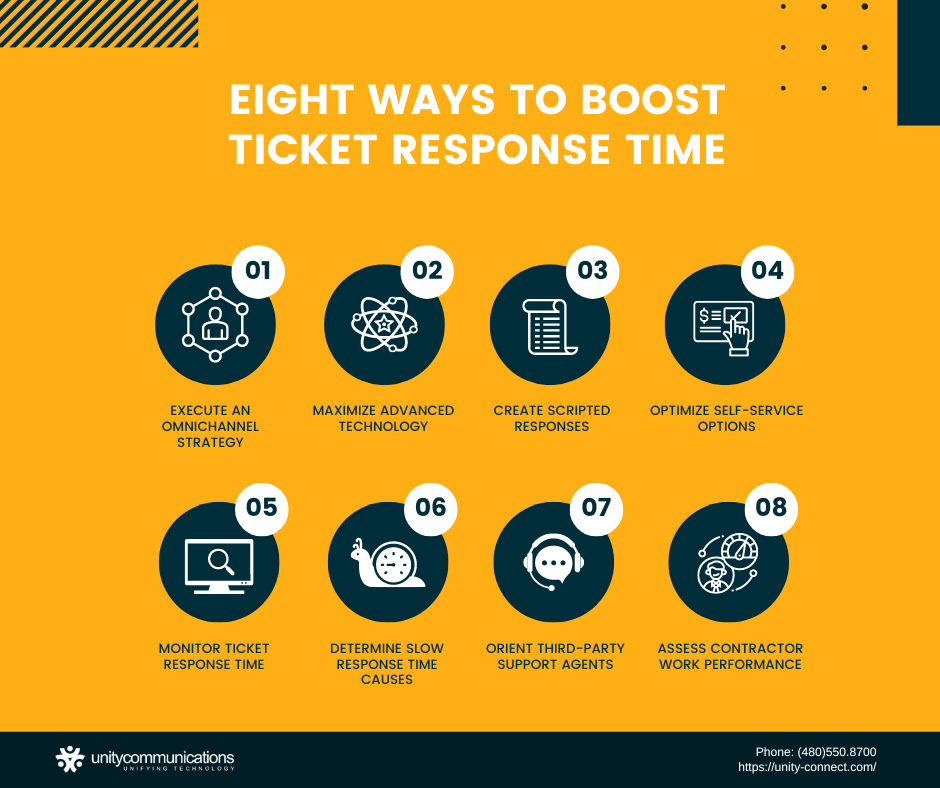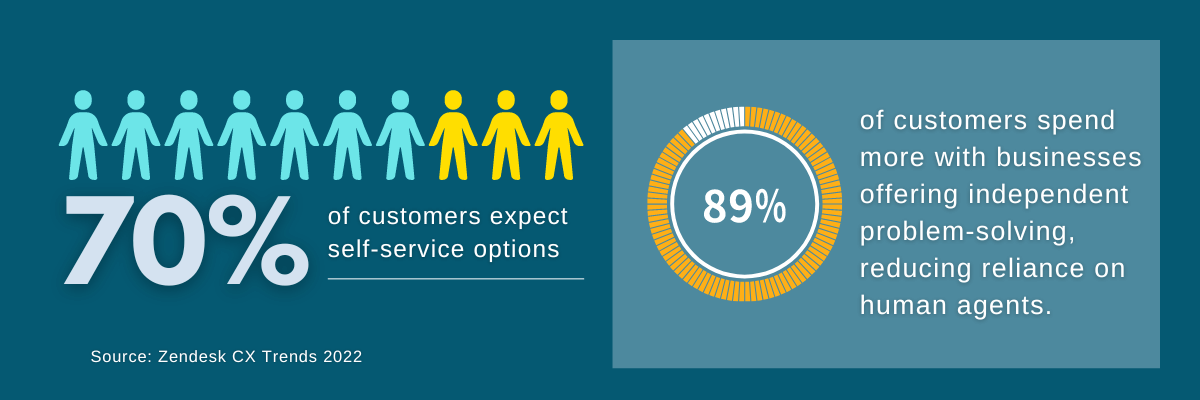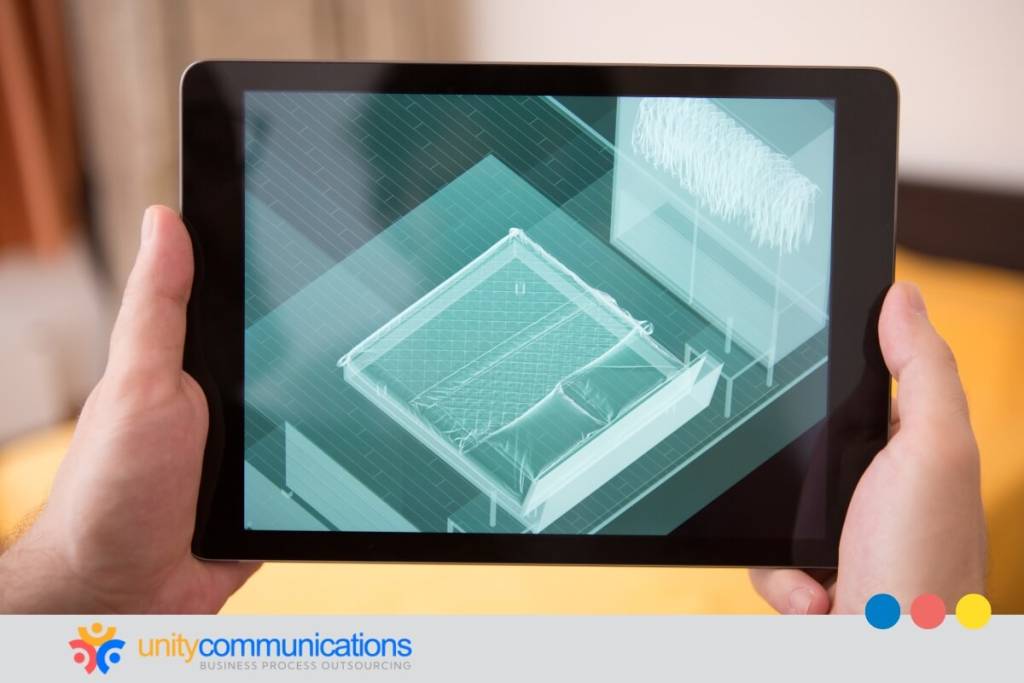Table of Contents
Trillions of transactions worldwide happen online, and digitization and automation make instant responses possible. However, businesses struggle to meet the demand for fast-paced information technology (IT) and desktop support because they must prioritize their core competencies and functions.
IT support outsourcing offers a cost-effective desktop support platform to improve your team’s ticket response time. Service providers also take practical measures to deliver fast and reliable support.
Read on to learn how to improve ticket response time for your outsourced desktop support.
Eight Ways To Boost Ticket Response Time

Given today’s technological advances, consumers expect fast replies from brands regarding their desktop purchases and concerns. Recent statistics from Emplifi show that 31% of American customers rated slow response time as the leading contributor to negative experiences.
As the market moves faster, companies that meet such evolving expectations have a higher chance of winning customer loyalty. Outsourcing your desktop support doubles your potential to retain more consumers.
Service providers use a help desk ticketing system to quickly and effectively address desktop support requests. They further enhance ticket response time by implementing best practices.
Explore eight ways to boost your ticket response time below:
1. Execute an Omnichannel Strategy
Front- and back-office outsourcing providers develop and implement an omnichannel approach to streamline desktop support ticketing. This customer-centric strategy integrates the following channels to deliver a seamless and consistent customer experience across all touchpoints:
- Voice calls. This phone-based support option lets consumers converse with agents to resolve desktop issues.
- Email. One of the most widely used customer service channels, email facilitates asynchronous communication, helping agents simplify support ticket management and distribution.
- Live chat. This channel lets consumers send and receive messages in real time and is ideal for those seeking instant responses to their inquiries.
- Text messaging. Customers and businesses use this channel to send electronic support requests and replies through short text messages. Digital advancement enables mobile messaging over internet-based services such as Messenger, WhatsApp, and Viber.
- Social media. This most comprehensive digital channel gives consumers more flexibility in expressing their desktop concerns. They can request support through social media posts, direct messages, or online reviews.
- Video chat. A reasonably new customer service channel, video chat allows live, on-camera desktop support over the internet.
In particular, the omnichannel help desk platform improves ticket response time by enabling desktop support agents to deliver a faster, more personalized customer experience.
Here are a few ways vendors optimize the solution for desktop support ticketing:
- Let customers submit requests and receive tickets via multiple channels. It also helps reduce the time it takes for tickets to reach customer service representatives (CSRs).
- Enable support agents to oversee tickets using a single dashboard. This way, they can quickly and efficiently respond to inquiries. For instance, agents can address a request via email and chat with another customer while keeping all necessary information intact.
- Gain a single view of transaction histories and customer data. Integrating a customer relationship management (CRM) system into an omnichannel desktop support platform allows support teams to have a single view of all previously ticketed customer interactions, purchases, and preferences.
- Automate routine tasks. Contractors optimize omnichannel to help automate ticket distribution and request prioritization tasks so that support agents can focus on more complex issues.
2. Maximize Advanced Technology
In addition to implementing an omnichannel strategy, business process outsourcing (BPO) vendors use emerging technologies to expedite desktop support ticketing. Expect to see or use the modern features below when outsourcing tech solutions:
- Artificial intelligence (AI) and machine learning (ML) simulate human intelligence to perform time-consuming, repetitive tasks. BPO providers incorporate AI and ML into ticketing systems to automate task categorization and ticket distribution processes. This helps improve ticket response time and problem resolution.
- Robotic process automation (RPA) automates the tedious procedure of handling desktop support tickets. Combined with AI and ML, RPA automatically creates and classifies tickets based on a customer inquiry’s urgency and difficulty. It also provides quick responses, primarily through email and chat.
- Natural language processing (NLP) technology allows the third-party desktop support platform to understand text and spoken words. The tool helps interpret issues and develop straightforward tickets, allowing CSRs to more accurately and promptly address customer inquiries.
- An automatic call distribution (ACD) platform accelerates desktop problem resolutions by automating call ticketing assignments based on an agent’s skill set and availability. The ACD system also automatically queues inbound calls based on the urgency and complexity of tech issues.
3. Create Scripted Responses
Drafting predefined customer responses and tickets helps third-party support agents quickly address common desktop inquiries. These scripts ensure the tickets automatically sent to customers are concise and consistent with the problems presented.
Such templates also reduce the time it takes CSRs to craft a reply from scratch when they need to intervene. These canned responses further enhance ticket response time by enabling the following capabilities:
- Consistency and accuracy. Scripted responses ensure tickets contain consistent and accurate information about customer purchases and concerns. These instant replies help improve customer satisfaction by reducing the likelihood of errors or misunderstandings.
- Fast acknowledgment. With preset responses, support agents can view and answer request tickets faster and more efficiently. They simply copy and paste the template that matches a consumer’s question.
- Complex issue prioritization. Since ticket responses are predefined and sent automatically, agents have more time to focus on high-priority issues. This capability reduces workloads and improves overall agent productivity.
- Better team collaboration. Service providers compile preset replies and tickets in a unified dashboard to ensure all third-party support agents receive the same dialogue script. Doing so improves the team’s cooperation and efficiency while boosting ticket responses.
4. Optimize Self-service Options
BPO vendors offer self-service options to streamline desktop support and improve ticket response speed.
Considering how fast the internet delivers comprehensive data when searching for a term, many consumers and desktop users seek solutions online. They conduct their research first before consulting their brands.
Seventy percent of polled customers expect a company to have a self-service portal or available web content. Another 89% of consumers spend more with businesses that let them find answers independently without contacting human agents.
Thus, service providers can help businesses accelerate ticket response time and increase their bottom line by deploying these self-service solutions:
- An automated email ticketing system automatically creates tickets once customers email their desktop support requests. It also enables seamless workflow by automating ticket responses and assignments. Tickets include suggestions and basic steps customers can take to resolve issues before human intervention.
- Chatbots enable service vendors to provide 24/7 desktop support. These software bots deliver instant and personalized ticket responses to common technical issues. They also automatically escalate complex problems to human agents when necessary.
- An interactive voice response system uses AI-powered speech recognition and voice menu features to automatically receive and route incoming calls for desktop support requests. It reduces wait time by providing self-service and call-back options.
- Aside from providing a help desk platform, vendors also offer mobile applications as part of their outsourced IT solutions. The focus of their development process is to optimize the applications for Google Pixel, iPhones, Galaxy phones, and other latest smartphones that have a wider market share.
In addition to these automated ticketing capabilities, other self-service options are available when acquiring desktop support outsourcing. BPO teams produce the following online resources to streamline your support services:
- A knowledge base is a centralized database that customers can access to find answers to common questions or simple issues. It includes blogs, FAQs, and other resources.
- Online community forums facilitate interactions between customers, support agents, and other technical experts. These virtual platforms enable parties to share information about desktop issues and complex tech problems.
- Accessible through company websites and video-sharing platforms, video tutorials contain step-by-step visual instructions for using desktop products and services. They also provide answers to common questions and resolutions for typical desktop issues.

5. Monitor Ticket Response Time
Tracking average first response time (AFRT) is the best way to ensure your chosen service provider addresses desktop support tickets in real time. AFRT refers to how long it takes to respond to a customer’s initial inquiry or ticket. The metric provides insights on what areas need improvement to maintain speed in addressing customer issues.
Similar to monitoring outsourced IT trends, the ideal and most effective AFRT varies depending on the sector, service scope, and available resources. In general, an AFRT of less than an hour is acceptable. An AFRT of more than a few hours might indicate a need to revamp your desktop support strategy.
Apart from using an automated ticketing system, discuss ways to closely monitor your response time with your service provider. You can follow the steps below to measure and boost your AFRT:
- Define the metrics. Identify and define the metrics you want to monitor to improve responses to desktop support requests; in this case, we have already defined the AFRT.
- Determine a target. Specify AFRT goals based on the type of customer inquiry and account status. These objectives let you measure your progress and identify improvement areas.
- Automate metric tracking. Ask your provider to set real-time AFRT monitoring on your help desk ticketing system. This capability notifies you when your third-party desktop support team cannot meet your agreed average ticket response time.
- Schedule regular analysis and reporting. Organize a short- or long-term timeline with your BPO partner for frequent AFRT data collection, analysis, and reporting. This step helps you review your ticket response achievements and flaws.
6. Determine Slow Response Time Causes
Help your desktop support provider spot the potential causes of slow responses to customer inquiries. This way, you can quickly formulate solutions to expedite your ticket response time. Below are some steps in determining possible causes of slow response time:
- Review ticket backlogs. Monitor the number of open tickets and the time remaining for their resolution. A large backlog of unresolved tickets indicates support agents respond to customer requests slowly.
- Examine call and chat data. Study call and chat data to measure the average time customers wait to connect with support agents. Consistently long average wait time means you need a new approach to accelerate desktop support.
- Review customer feedback. Analyze post-support feedback recorded in your ticketing system to know whether customers complain about slow responses to their concerns.
- Conduct time studies. This action provides an overview of the time support agents need to complete basic tasks or resolve common issues.
- Perform a root cause analysis. This step lets you understand why your third-party desktop support team takes longer than usual to address customer issues.
7. Orient Third-party Support Agents
Once you have signed an official contract for front- and back-office outsourcing services, brief your third-party desktop support agents about your products, services, and daily operations. This helps improve ticket response time by ensuring the third-party team knows what to do when providing desktop support services.
Despite a ticketing system’s autonomous capabilities to speed up desktop support responses, you still need to orient third-party CSRs regarding your business setup. Talk to your BPO partner about providing agents with the required training and orientation. Proper training ensures the team understands how to address tickets for complex issues.
You can ask the provider to organize a virtual or in-person training session. Provide the critical resources and documents containing your desktop support strategies and services. Also, cover these steps to improve your overall ticket response rate:
- Ensure third-party CSRs know your business operations and offerings. Provide manuals or presentations detailing your desktop products and services. This familiarizes CSRs with the related features and functionalities.
- Match communication training techniques. Although your BPO partner handles communication training for support agents, you must ensure the approach aligns with yours. Doing so avoids future conflicts and misunderstandings.
- Instruct your vendor to provide technical training on your desktop solutions. This training is necessary to teach third-party agents how to effectively diagnose and troubleshoot tech issues related to your offerings.
- Align your provider’s customer service training with yours. Customer service training warrants a support team’s ability to professionally and efficiently handle consumer inquiries. Provide guidelines for how you want BPO agents to treat rude customers, implement de-escalation techniques, and resolve desktop problems.
- Require time management coaching. Time management is crucial to delivering effective and quick ticket responses, especially for complicated issues. Direct your provider to train support agents on task prioritization and time management techniques.
- Provide access to your knowledge base. BPO agents need easily accessible desktop support content as much as customers do. They need FAQs and articles to help them find solutions quickly and independently. These insights allow them to respond to customers faster.
8. Assess Contractor Work Performance
As part of outsourcing desktop support and related data entry services, frequently evaluate your contractor’s work performance to ensure it meets your expected ticket response speed and time.
The following steps let you identify whether your BPO partner meets your preset service levels and address any issues affecting your ticket responses.
- Use a ticketing system to monitor the provider’s ticket response time automatically. Set a benchmark for AFRT and observe how often third-party agents meet the target.
- Perform customer satisfaction surveys to measure the provider’s service quality. Ask consumers to rate your vendor’s response time, problem resolution, and overall customer service.
- Review call recordings, chat transcripts, or ticket emails to analyze the vendor’s service quality and productivity. The collected insights show whether the contractor follows the correct procedures when addressing desktop support inquiries.
- Review vendor-provided metrics and reports. These critical criteria and documents include data on ticket volume, resolution time, and other key performance indicators (KPI). Use such information to list improvement areas and work with the contractor to implement solutions.
- Conduct regular agent performance assessments with your BPO partner. Use this opportunity to tackle any concerns and provide guidance on boosting ticket responses.
Consider customer response speed when planning to outsource desktop support and looking to understand what an outsourced IT provider is. The points discussed above should guide you in ensuring your selected service provider can meet your desired ticket response goals for customer satisfaction and retention.
The Bottom Line
Improving your ticket response time starts by executing an omnichannel platform to oversee customer requests across multiple touchpoints. Scripts, advanced technologies, and self-service options also generate faster consumer responses.
The criteria for tracking AFRT and slow response times provide insights into the areas you and your provider must focus on and enhance. Contributing to third-party support agent training and regularly assessing your vendor’s work performance ensures you meet the increasing demand for fast desktop support.
When you hire a BPO service provider such as Unity Communications, you prevent customer churn by responding to their concerns quickly and effectively. Short response time for ticket requests also helps expand your bottom line and loyal customer base.



